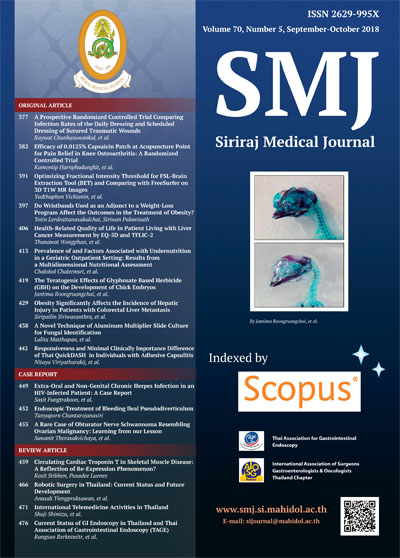The Teratogenic Effects of Glyphosate Based Herbicide (GBH) on the Development of Chick Embryos
Keywords:
Glyphosate; ROUNDUP; teratogen; chick embryoAbstract
Objective: This study was conducted to investigate the teratogenic effects of GBH by using chick embryo as an
animal model.
Methods: The equal volume of 0.1 ml of 0.01%, 0.05%, 0.3%, and 0.5% w/v glyphosate solution were injected into
yolk sacs of fertilized White Leghorn eggs at 21 h of incubation and repeated at the volume of 0.05 ml on the 3rd
day of incubation. The embryos were observed for abnormalities on day 3, 6 and 10 of incubation.
Results: The results showed that the mortality percentages increased as the concentration of glyphosate increased.
Day 3 chick embryos showed retardation of development and several abnormalities, for instance, the irregular shape
of the brain vesicles with an opening of anterior neuropore, small eye primordia with the optic cup and lens vesicle
retardation, looser of the heart looping with dilated lumen, lesser number of branchial arches, absent of limb bud
or tail fold. Day 6 chick embryos showed severe retardation of several organs. Microphthalmia, anophthalmia,
ectopia cordis and ectopic viscerae were observed in day 6 chick embryos. On day 10, most embryos died earlier
and living embryos showed normal external features but delayed ossifications which were significantly different
from the control (P<0.05).
Conclusion: Glyphosate was toxic to chick embryos which directly caused mortality and was also a powerful teratogen
which caused growth retardation and malformations on day 3 and day 6 and skeletal alteration on day. The effects
were predicted to occur in other embryos including humans. Pregnant women should avoid contamination with
GBH especially in the first trimester of pregnancy.
Downloads
Published
How to Cite
Issue
Section
License
Authors who publish with this journal agree to the following conditions:
Copyright Transfer
In submitting a manuscript, the authors acknowledge that the work will become the copyrighted property of Siriraj Medical Journal upon publication.
License
Articles are licensed under a Creative Commons Attribution-NonCommercial-NoDerivatives 4.0 International License (CC BY-NC-ND 4.0). This license allows for the sharing of the work for non-commercial purposes with proper attribution to the authors and the journal. However, it does not permit modifications or the creation of derivative works.
Sharing and Access
Authors are encouraged to share their article on their personal or institutional websites and through other non-commercial platforms. Doing so can increase readership and citations.











